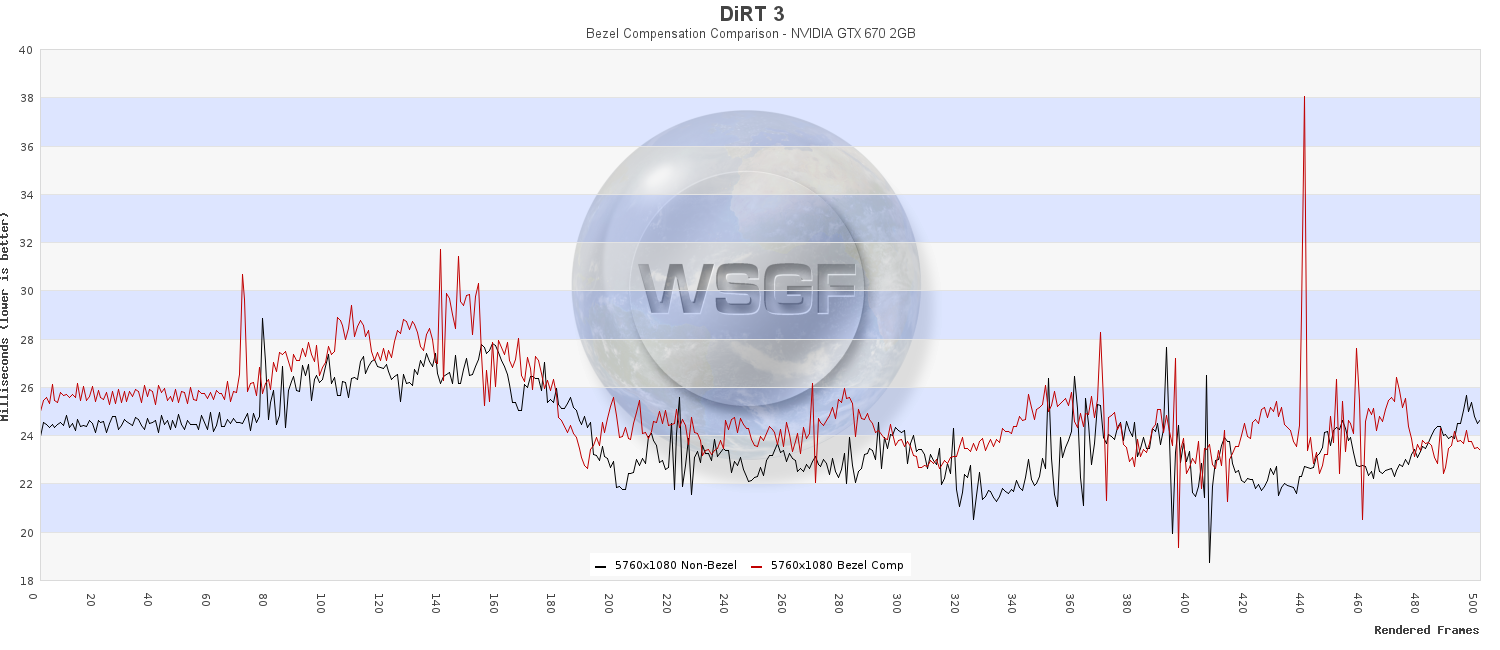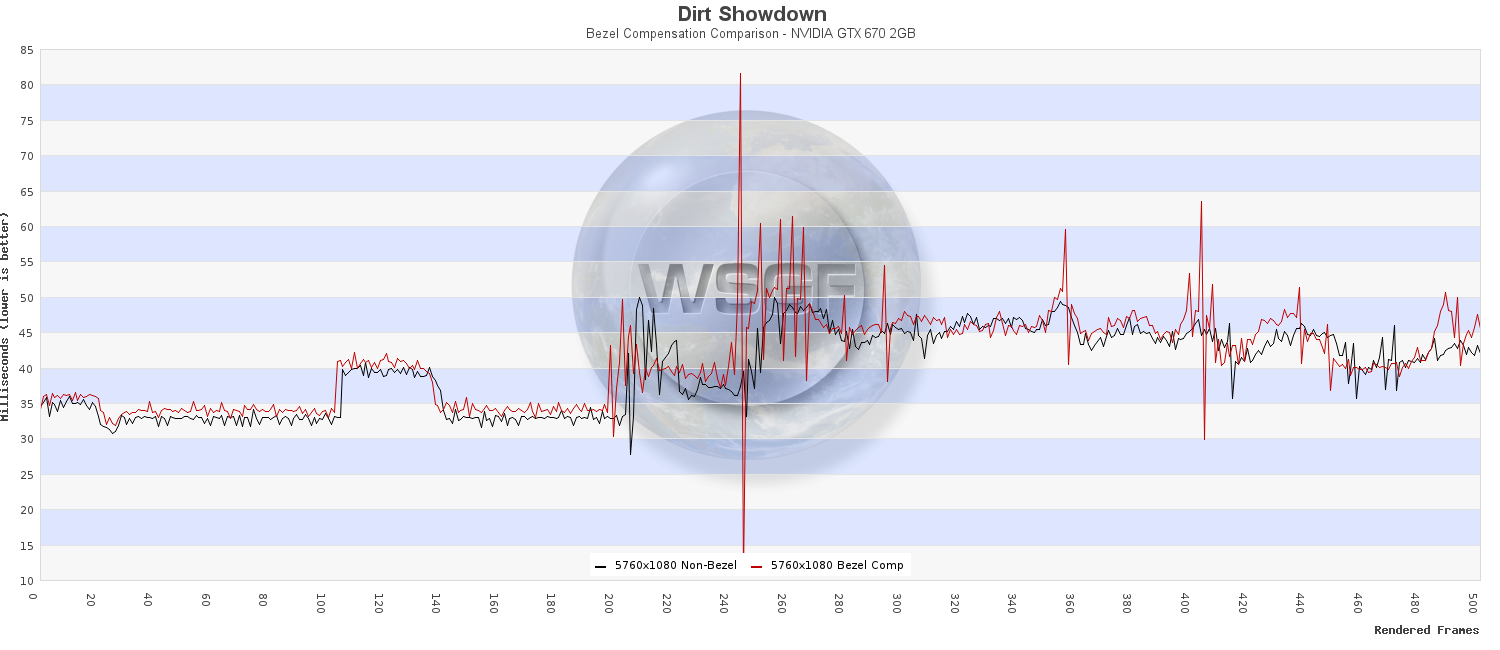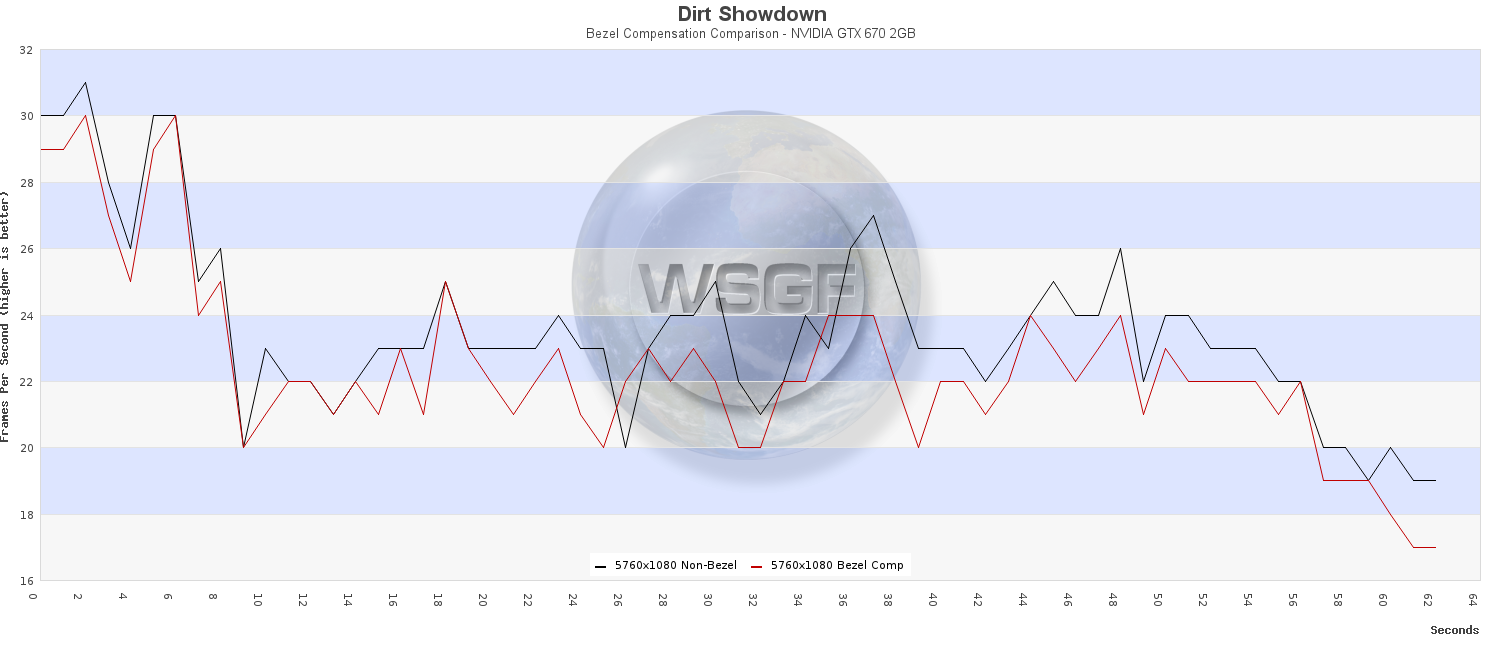Benchmarking Bezel Compensation - Page 2
Dirt 3
Dirt 3 was tested at 4xAA, 16xAF with the Ultra preset. The game provides a more consistent frame time, offering a smoother experience. As with the AVP benchmark, the bezel compensated resolution runs about 2ms slower frame time than the nature resolution. The single hitch in the bezel compensated is an anomaly and is not repeated during the benchmark. The differences between the two data sets is partly due to the native of the Dirt 3 benchmarking routine.
The Dirt 3 benchmark is not a canned fly-through of the game. It simulates a race using the AI of the opponent cars. Thus each race is slightly different, and one race can complete smoothly while another ends up in multi-car crashes.
Overall the bezel compensated resolution runs a consistent 2fps slower than the native resolution.


Dirt Showdown
Dirt Showdown is the latest entry in the Dirt series, and has been met with a polarized response from fans. The game moves away from the rally genre, and into more arcade territory. Showdown is a destruction derby game, and gives destructible and arcade trappings to short course races where contact is encouraged. It also allows for arcade style stunts, jumps and acrobatics. The change in style left many people with a poor outlook on the game.
From a technical standpoint, the game offered a number of differences from it predecessors. The game was released being moderately Vert- for Surround and Eyefinity. We approached Codemasters on this issue and found that they had intentionally placed a max hFOV on the game to avoid clipping on the confined track. An .ini option was added in subsequent patches, which allowed the user to enter a fully Hor+ FOV. On a positive note, Showdown was the first title to offer additional Advanced Lighting and Global Illumination features. The game was tested at 4xAA, 16AF, Ultra preset and Advanced Lighting and Global Illumination enabled.
As with Dirt 3, the Showdown benchmark is not a canned affair. It is a real-time simulation of a race, and the experience varies from one run to the next. Races are even more varied in the Showdown benchmark due to the short, confined track which a has criss-crossing path. In the 500ms frametime graph you will see a couple of anomalies due to crashes and car interaction, on the bezel compensated data set. On the full run through, the non-bezel compensated data set offered these at points later in the test.
Overall the two data sets closely match each other and offer relatively smooth frame rates. In many instances the two frame rates match identically, though the larger resolution will periodically trail by a frame or too.


Conclusions
Overall each the increased resolutions of bezel compensation produces an impact of between less than 1fps, and just over 2.5fps. This doesn't take into account the somehow better performance of Mafia II. Considering the modest performance baselines, these small impacts result in a performance loss of just over 4%. While the perceptive loss is minimal, this does fall right in line with the 4.9% increase in pixel count.
As I was writing the conclusions, it dawned on me that I wasn't sure if the performance drop from bezel-compensation would best be characterized as "1-2 frames" or "4-5%". To settle on a final conclusion, I needed a game that would consistently run north of 60fps. I had originally intended to test H.A.W.X. 2 for this article, but the Surround resolutions are freaking out and throwing a hypnotic/psychadelic/acid-trip montage of artifacts and triangles all over the screen. 1080p is fine, but Surround is broken. I updated drivers, but still have the issues.
Dirt 3 is one of the better performing titles, so I decided to give that a spin at lower settings. I ran the two resolutions at the Medium preset and ended up with the following (avg / min / total frames):
- Non-Bezel: 91.7 / 75.3 / 9,114
- Bezel: 87.3 / 71.9 / 8,677
Dirt 3 provides those stats at the end of the benchmark run, so I know its consistent from a start and stop perspective. I took the numbers off the third run. Performance is always a bit lower on the first run (especially min framerate). These numbers shows that the avg fps and the total frames fell by 5%, while the minimum fell by 4.7%.
With this finding I can comfortably say that the performance hit with bezel compensation will be comparable to the percent increase to your pixel count. While 5% may sound like a lot, in practice it's really not. At 30-40 fps, we're talking 1-2 fps; at 60-90 fps we're talking 4-5 fps. Additionally, the resulting "odd" resolutions and aspect ratios do not produce any anomalies with frame times or smoothness.
